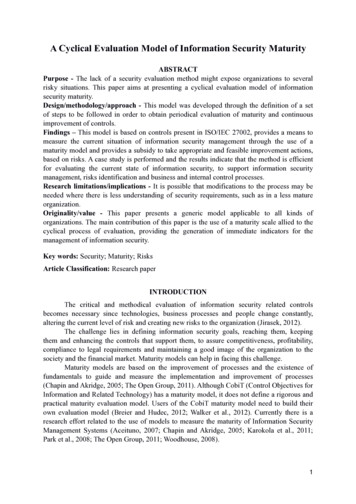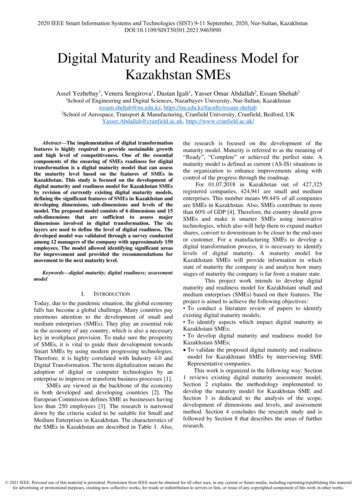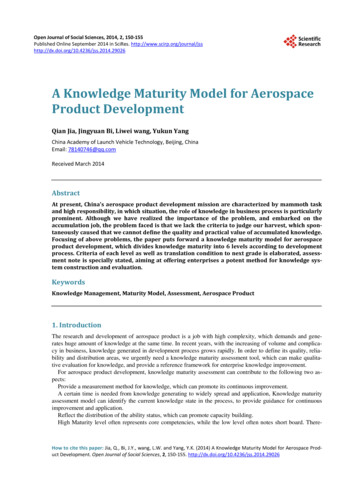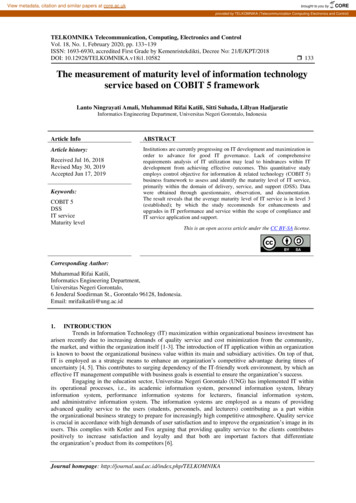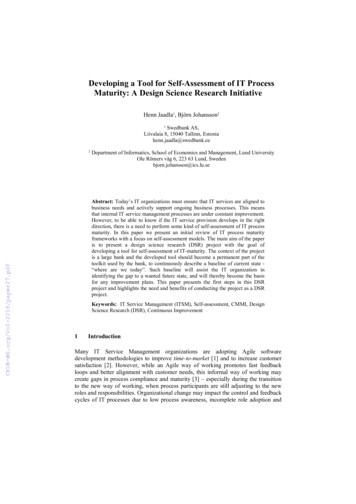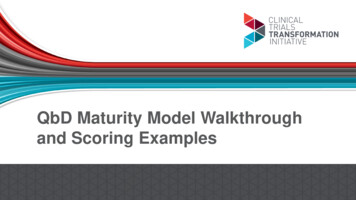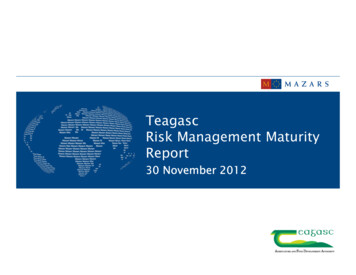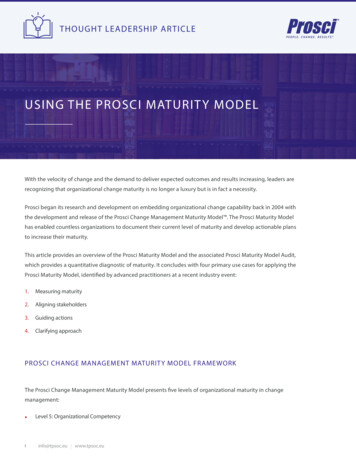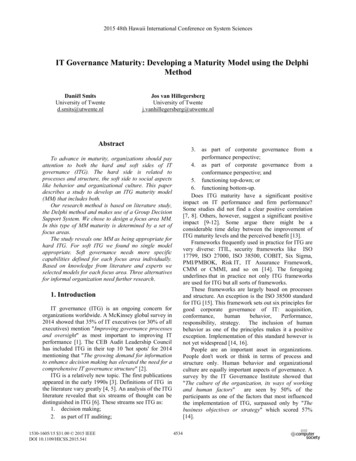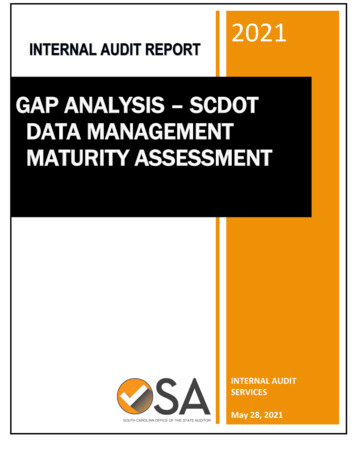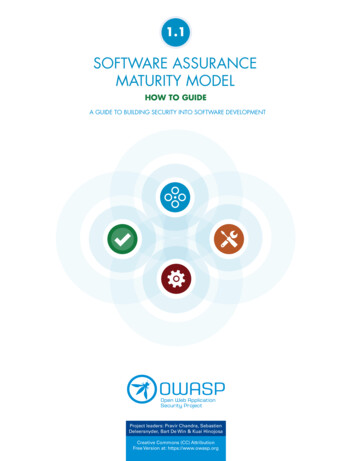
Transcription
1.1SOFTWARE ASSURANCEMATURITY MODELHOW TO GUIDEA GUIDE TO BUILDING SECURITY INTO SOFTWARE DEVELOPMENTProject leaders: Pravir Chandra, SebastienDeleersnyder, Bart De Win & Kuai HinojosaCreative Commons (CC) AttributionFree Version at: https://www.owasp.org
This is an OWASP ProjectOWASP is an international organization and the OWASP Foundation supports OWASP effortsaround the world. OWASP is an open community dedicated to enabling organizations to conceive,develop, acquire, operate, and maintain applications that can be trusted. All of the OWASP tools,documents, forums, and chapters are free and open to anyone interested in improving applicationsecurity. We advocate approaching application security as a people, process, and technologyproblem because the most effective approaches to application security include improvements inall of these areas. We can be found at https://www.owasp.org.LicenseThis work is licensed under the Creative Commons Attribution-Share Alike 4.0 License. To view acopy of this license, visit https://creativecommons.org/licenses/by-sa/4.0/ or send an email toinfo@creativecommons.org. or send a letter to Creative Commons, PO Box 1866, Mountain View,CA 94042.
CONTENTSCONTENTS02Executive Summary03Software Development04SAMM Evolution06Applying The Model07Using The Maturity Levels08Related Levels08Conducting Assessments09Creating Scorecards11Building Assurance Programs14Independent Software Vendor16Online Service Provider18Financial Services Organization20Government Organization22Case Study23Virtualware26Virtualware - Phase 129Virtualware - Phase 232Virtualware - Phase 335Virtualware - Phase 438Virtualware - Ongoing40Acknowledgements And Sponsors4016Contributors & Reviewers41Sponsors1
2EXECUTIVE SUMMARYEXECUTIVE SUMMARYThe Software Assurance Maturity Model (SAMM) is an open framework to help organizations formulate and implement a strategy for software security that is tailored to the specific risks facing theorganization. The resources provided by SAMM will aid in: Evaluating an organization’s existing software security practices Building a balanced software security assurance program in well-defined iterations Demonstrating concrete improvements to a security assurance program Defining and measuring security-related activities throughout an organizationSAMM was defined with flexibility in mind such that it can be utilized by small, medium, and largeorganizations using any style of development.As an open project, SAMM content shall always remain vendor-neutral and freely available for allBesides the How-To Guide and the Core Model document, several other tools and documents havebeen made available during the last years: The new Quick-Start Guide walks you through the core steps to execute your SAMM based securesoftware practice The updated SAMM Tool Box can be used to perform SAMM assessments and create SAMMroadmaps Lots of OWASP resources are linked from the OpenSAMM project page on the OWASP web site.You can use these to implement SAMM roadmaps With the SAMM Benchmark data you can compare your maturity and progress with other similarorganizations and teams
EXECUTIVE SUMMARY3SOFTWARE DEVELOPMENT- SAMM Overview -Business FunctionsGovernanceSTRATEGY& METRICSEDUCATION& GUIDANCEPOLICY NT
4SAMM EVOLUTIONSAMM EVOLUTIONSAMM v1.0 was originally developed, designed, and written by Pravir Chandra. As part of the v1.1release, this How-To Guide splits off the SAMM implementation guidance from the SAMM CoreModel document.SAMMV1.0QUICKSTARTGUIDEV1.1HOW TOGUIDEV1.1COREMODELV1.1TOOL BOXV1.1OWASPRESOURCESV1.1SAMMBENCHMARKSPLIT & IMPROVENEW
5
6APPLYING THE MODELAPPLYING THE MODELPutting it all to workThis section covers several important and useful applications ofSAMM. Given the core design of the model itself, an organization canuse SAMM as a benchmark to measure its security assurance programand create a scorecard. Using scorecards, an organization can demonstrate improvement through iterations of developing an assuranceprogram. And most importantly, an organization can use SAMM roadmap templates to guide the build-out or improvement of a securityassurance initiative.
USING THE MATURITY LEVELS7USING THE MATURITY LEVELSEach of the twelve Security Practices have three Maturity Levels. Each Level has several components thatspecify the critical factors for understanding and achieving the stated Level. Beyond that, these prescriptivedetails make it possible to use the definitions of the Security Practices even outside the context of usingSAMM to build a software assurance program.ObjectiveThe Objective is a general statement that captures the assurance goal of attaining the associated Level. As theLevels increase for a given Practice, the Objectives characterize more sophisticated goals in terms of buildingassurance for software development, deployment and operations.ActivitiesThe Activities are core requisites for attaining the Level. Some are meant to be performed organization-wideand some correspond to actions for individual project teams. In either case, the Activities capture the coresecurity function and organizations are free to determine how they fulfill the Activities.ResultsThe Results characterize capabilities and deliverables obtained by achieving the given Level. In some casesthese are specified concretely and in others, a more qualitative statement is made about increased capability.Success MetricsThe Success Metrics specify example measurements that can be used to check if an organization is performing at the given Level. Data collection and management is left to the choice of each organization, but recommended data sources and thresholds are provided.PERSONNELDevelopers:Individuals performing detailed design and implementation of the softwareArchitects:Individuals performing high-level design work and large scale system engineeringManagers:Individuals performing day-today management of development staffQA Testers:Individuals performing quality assurance testing and prerelease verification of softwareSecurity:Auditors Individuals with technical security knowledge related to software being producedBusiness Owners:Individuals performing key decision making on software and its business requirementsSupport Operations:Individuals performing customer support or direct technical operations support
8RELATED LEVELS CONDUCTING ASSESSMENTSRELATED LEVELSThe Related Levels are references to Levels within other Practices that have some potential overlaps depending upon the organization’s structure and progress in building an assurance program. Functionally, these indicate synergies or optimizations in Activity implementation if the Related Level is also a goal or already in place.CONDUCTING ASSESSMENTSBy measuring an organization against the defined Security Practices, an overall picture of built-in securityassurance activities is created. This type of assessment is useful for understanding the breadth of security activities currently in place at an organization. Further, it enables that organization to then utilize SAMM to createa future roadmap for iterative improvement.An important first step of the assessment is to define the scope of the assessment: An assessment can bedone for a complete organisation, for selected business units or even on development team level. This scopemust be agreed upon with the involved key stakeholders.The process of conducting an assessment is simply evaluating an organization to determine the MaturityLevel at which it is performing, The extent to which an organization’s performance is checked will usually varyaccording to the drivers behind the assessment, but in general, there are two recommended styles:Lightweight:The assessment worksheets for each Practice are evaluated and scores are assigned based on answers. Thistype of assessment is usually sufficient for an organization that is trying to map their existing assurance program into SAMM and just wants to get a quick picture of where they stand.Detailed:After completion of the assessment worksheets, additional audit work is performed to check the organizationto ensure the Activities prescribed by each Practice are in place. Additionally since each Practice also specifiesSuccess Metrics, that data should be collected to ensure that the organization is performing as expected.STARTCOMPLETEASSESSMENTWORKSHEETSASSIGNA SCORE PERPRACTICELIGHTWEIGHTENDDETAILEDAUDIT RE PERPRACTICE
CONDUCTING ASSESSMENTS CREATING SCORECARDS9Scoring an organization using the assessment worksheets is straightforward. After answering the questions, evaluate the answer column to determine the Level. It is indicated by affirmative answers on allquestions above the markers to the right of the answer column.Existing assurance programs might not always consist of activities that neatly fall on a boundary between Maturity Levels, e.g. an organization that assesses to a Level 1 for a given Practice might alsohave additional activities in place but not such that Level 2 is completed. For such cases, the organization’s score should be annotated with a “ ” symbol to indicate there’s additional assurances in placebeyond those indicated by the Level obtained. For example, an organization that is performing allLevel 1 Activities for Operational Enablement as well as one Level 2 or 3 Activity would be assigned a“1 ” score. Likewise, an organization performing all Activities for a Security Practice, including somebeyond the scope of SAMM, would be given a “3 ” score.You can find the assessment worksheets in the SAMM Core Model document as of page 18. As of v1.1of SAMM, a separate SAMM Toolbox is made available to automate assessments. You can downloadthe SAMM Toolbox from the SAMM page on the OWASP web site.00112233ASSESSMENT SCORESCREATING SCORECARDSBased on the scores assigned to each Security Practice, an organization can create a scorecard tocapture those values. Functionally, a scorecard can be the simple set of 12 scores for a particulartime. However, selecting a time interval over which to generate a scorecard facilitates understanding of overall changes in the assurance program during the time frame.Using interval scorecards is encouraged for several situations:Gap analysisCapturing scores from detailed assessments versus expected performance levelsDemonstrating improvementCapturing scores from before and after an iteration of assuranceprogram build-outOngoing measurementCapturing scores over consistent time frames for an assurance program that is already in placeThe figure below shows an example scorecard for how an organization’s assurance programchanged over the course of one year. If that organization had also saved the data about where theywere planning on being at the end of the year, that would be another interesting data set to plotsince it would help show the extent to which the plans had to change over the year.
10CREATING SCORECARDS BUILDING ASSURANCE PROGRAMSBEFOREAFTERSTRATEGY & METRICS23POLICY & COMPLIANCE12EDUCATION & GUIDANCE12THREAT ASSESSMENT12SECURITY REQUIREMENTS03SECURE ARCHITECTURE01DESIGN REVIEW12IMPLEMENTATION REVIEW23SECURITY TESTING12ISSUE MANAGEMENT01ENVIRONMENT HARDENING11OPERATIONAL ENABLEMENT23BUILDING ASSURANCE PROGRAMSOne of the main uses of SAMM is to help organizations build software security assurance programs.That process is straightforward, and generally begins with an assessment if the organization is already performing some security assurance activities.Several roadmap templates for common types of organizations are provided. Thus, many organizations can choose an appropriate match and then tailor the roadmap template to their needs. Forother types of organizations, it may be necessary to build a custom roadmap.Roadmaps (pictured to the right) consist of phases (the vertical bars) in which several Practices areeach improved by one Level. Therefore, building a roadmap entails selection of which Practices toimprove in each planned phase. Organizations are free to plan into the future as far as they wish, butare encouraged to iterate based on business drivers and organization-specific information to ensurethe assurance goals are commensurate with their business goals and risk tolerance.
BUILDING ASSURANCE PROGRAMSAfter a roadmap is established, the build-out of an assurance program is simple. An organization begins an improvement phases and works to achieve the stated Levels by performing the prescribedActivities. At the end of the phase, the roadmap should be adjusted based on what was actuallyaccomplished, and then the next phase can begin.CONDUCTINITIALASSESSMENTSTARTAUDIT DINGANOTHERPHASE?NODONEYESSELECTPRACTICES TOIMPROVEMARK SELECTEDIMPROVEMENTSON ROADMAPYESSELECTAPPROPRIATEROADMAPADJUSTROADMAP TOORGANIZATION11
12 BUILDING ASSURANCE PROGRAMSPHASE 1STRATEGY & METRICSPOLICY & COMPLIANCEEDUCATION & GUIDANCETHREAT ASSESSMENTSECURITY REQUIREMENTSSECURE ARCHITECTUREDESIGN REVIEWIMPLEMENTATION REVIEWSECURITY TESTINGISSUE MANAGEMENTENVIRONMENT HARDENINGOPERATIONAL ENABLEMENTPHASE 2PHASE 3PHASE 4
13
14 INDEPENDENT SOFTWARE VENDORINDEPENDENT SOFTWARE VENDORROADMAP TEMPLATERationaleAn Independent Software Vendor involves the core business function of building and selling software components and applications.Initial drivers to limit common vulnerabilities affecting customers and users leads to early concentration on Implementation Review and Security Testing activities.Shifting toward more proactive prevention of security errors in product specification, an organization adds activities for Security Requirements over time.Also, to minimize the impact from any discovered security issues, the organization ramps up Issuemanagement activities over time.As the organization matures, knowledge transfer activities from Operational Enablement are addedto better inform customers and users about secure operation of the software.Additional ConsiderationsOutsourced DevelopmentFor organizations using external development resources, restrictions on code access typically leadsto prioritization of Security Requirements activities instead of Implementation Review activities.Additionally, advancing Threat Assessment in earlier phases would allow the organization to betterclarify security needs to the outsourced developers. Since expertise on software configuration willgenerally be strongest within the outsourced group, contracts should be constructed to account forthe activities related to Operational Enablement.Internet-Connected ApplicationsOrganizations building applications that use online resources have additional risks from the coreInternet-facing infrastructure that hosts the Internet-facing systems. To account for this risk, organizations should add activities from Environment Hardening to their roadmaps.Drivers and Embedded DevelopmentFor organizations building low-level drivers or software for embedded systems, security vulnerabilities in software design can be more damaging and costly to repair. Therefore, roadmaps should bemodified to emphasize Secure Architecture and Design Review activities in earlier phases.Organizations Grown by AcquisitionIn an organization grown by acquisition, there can often be several project teams following differentdevelopment models with varying degrees of security-related activities incorporated. An organization such as this may require a separate roadmap for each division or project team to account forvarying starting points as well as project-specific concerns if a variety of software types are beingdeveloped.
INDEPENDENT SOFTWARE VENDORPHASE 1STRATEGY & METRICSPOLICY & COMPLIANCEEDUCATION & GUIDANCETHREAT ASSESSMENTSECURITY REQUIREMENTSSECURE ARCHITECTUREDESIGN REVIEWIMPLEMENTATION REVIEWSECURITY TESTINGISSUE MANAGEMENTENVIRONMENT HARDENINGOPERATIONAL ENABLEMENTPHASE 2PHASE 3PHASE 415
16 ONLINE SERVICE PROVIDERONLINE SERVICE PROVIDERROADMAP TEMPLATERationaleAn Online Services Provider involves the core business function of building web applications andother network-accessible interfaces.Initial drivers to validate the overall soundness of design without stifling innovation lead to earlyconcentration on Design Review and Security Testing activities.Since critical systems will be network-facing, Environment Hardening activities are also added earlyand ramped over time to account for risks from the hosted environment.Though it can vary based on the core business of the organizations, Policy & Compliance activitiesshould be started early and then advanced according to the criticality of external compliance drivers.As the organization matures, activities from Threat Assessment, Security Requirements, and SecureArchitecture are slowly added to help bolster proactive security after some baseline expectationsfor security have been established.Additional ConsiderationsOutsourced DevelopmentFor organizations using external development resources, restrictions on code access typically leadsto prioritization of Security Requirements activities instead of Implementation Review activities.Additionally, advancing Threat Assessment in earlier phases would allow the organization to betterclarify security needs to the outsourced developers. Since expertise on software configuration willgenerally be strongest within the outsourced group, contracts should be constructed to account forthe activities related to Operational Enablement.Online Payment ProcessingOrganizations required to be in compliance with the Payment Card Industry Data Security Standard(PCI-DSS) or other online payment standards should place activities from Policy & Compliance inearlier phases of the roadmap. This allows the organization to opportunistically establish activitiesthat ensure compliance and enable the future roadmap to be tailored accordingly.Web Services PlatformsFor organizations building web services platforms, design errors can carry additional risks and bemore costly to mitigate. Therefore, activities from Threat Assessment, Security Requirements, andSecure Architecture should be placed in earlier phases of the roadmap.Organizations Grown by AcquisitionIn an organization grown by acquisition, there can often be several project teams following differentdevelopment models with varying degrees of security-related activities incorporated. An organization such as this may require a separate roadmap for each division or project team to account forvarying starting points as well as project-specific concerns if a variety of software types are beingdeveloped.
ONLINE SERVICE PROVIDERPHASE 1STRATEGY & METRICSPOLICY & COMPLIANCEEDUCATION & GUIDANCETHREAT ASSESSMENTSECURITY REQUIREMENTSSECURE ARCHITECTUREDESIGN REVIEWIMPLEMENTATION REVIEWSECURITY TESTINGISSUE MANAGEMENTENVIRONMENT HARDENINGOPERATIONAL ENABLEMENTPHASE 2PHASE 3PHASE 4PHASE 517
18FINANCIAL SERVICES ORGANIZATIONFINANCIAL SERVICES ORGANIZATIONROADMAP TEMPLATERationaleA Financial Services Organization involves the core business function of building systems to support financial transactions and processing. In general, this implies a greater concentration of internal and back-end systems that interface with disparate external data providers.Initially, effort is focused on improving the Practices related to Governance since these are criticalservices that set the baseline for the assurance program and help meet compliance requirementsfor the organization.Since building secure and reliable software proactively is an overall goal, Practices within Construction are started early on and ramped up sharply as the program matures.Verification activities are also ramped up smoothly over the course of the roadmap to handle legacysystems without creating unrealistic expectations. Additionally, this helps ensure enough cycles arespent building out more proactive Practices.Since a financial services organization often operates the software they build, focus is given to thePractices within Operations during the middle of the roadmap after some initial Governance is inplace but before heavy focus is given to the proactive Construction Practices.Additional ConsiderationsOutsourced Development:For organizations using external development resources, restrictions on code access typically leadsto prioritization of Security Requirements activities instead of Implementation Review activities.Additionally, advancing Threat Assessment in earlier phases would allow the organization to betterclarify security needs to the outsourced developers. Since expertise on software configuration willgenerally be strongest within the outsourced group, contracts should be constructed to account forthe activities related to Operational Enablement.Web Services Platforms:For organizations building web services platforms, design errors can carry additional risks and bemore costly to mitigate. Therefore, activities from Threat Assessment, Security Requirements, andSecure Architecture should be placed in earlier phases of the roadmap.Organizations Grown by Acquisition:In an organization grown by acquisition, there can often be several project teams following differentdevelopment models with varying degrees of security-related activities incorporated. An organization such as this may require a separate roadmap for each division or project team to account forvarying starting points as well as project-specific concerns if a variety of software types are beingdeveloped.
FINANCIAL SERVICES ORGANIZATIONPHASE 1STRATEGY & METRICSPOLICY & COMPLIANCEEDUCATION & GUIDANCETHREAT ASSESSMENTSECURITY REQUIREMENTSSECURE ARCHITECTUREDESIGN REVIEWIMPLEMENTATION REVIEWSECURITY TESTINGISSUE MANAGEMENTENVIRONMENT HARDENINGOPERATIONAL ENABLEMENTPHASE 2PHASE 3PHASE 4PHASE 519
20 GOVERNMENT ORGANIZATIONGOVERNMENT ORGANIZATIONROADMAP TEMPLATERationaleA Government Organization involves the core business function of being a state-affiliated organization that builds software to support public sector projects.Initially, Governance Practices are established, generally to get an idea of the overall complianceburden for the organization in context of the concrete roadmap for improvement.Because of risks of public exposure and the quantity of legacy code generally in place, early emphasis is given to Security Testing within the Verification Practices and later the more involved Implementation Review or Design Review Practices are developed.Similar emphasis is placed on the Construction and Operations Practices. This helps establish theorganization’s management of vulnerabilities and moves toward bolstering the security posture ofthe operating environment. At the same time, proactive security activities under Construction arebuilt up to help prevent new issues in software under development.Additional ConsiderationsOutsourced Development:For organizations using external development resources, restrictions on code access typically leadsto prioritization of Security Requirements activities instead of Implementation Review activities.Additionally, advancing Threat Assessment in earlier phases would allow the organization to betterclarify security needs to the outsourced developers. Since expertise on software configuration willgenerally be strongest within the outsourced group, contracts should be constructed to account forthe activities related to Operational Enablement.Web Services Platforms:For organizations building web services platforms, design errors can carry additional risks and bemore costly to mitigate. Therefore, activities from Threat Assessment, Security Requirements, andSecure Architecture should be placed in earlier phases of the roadmap.Regulatory Compliance:For organizations under heavy regulations that affect business processes, the build-out of the Policy& Compliance Practice should be adjusted to accommodate external drivers. Likewise, organizations under a lighter compliance load should take the opportunity to push back build-out of thatPractice in favor of others.
GOVERNMENT ORGANIZATIONPHASE 1STRATEGY & METRICSPOLICY & COMPLIANCEEDUCATION & GUIDANCETHREAT ASSESSMENTSECURITY REQUIREMENTSSECURE ARCHITECTUREDESIGN REVIEWIMPLEMENTATION REVIEWSECURITY TESTINGISSUE MANAGEMENTENVIRONMENT HARDENINGOPERATIONAL ENABLEMENTPHASE 2PHASE 3PHASE 4PHASE 5PHASE 621
22 CASE STUDYCASE STUDYA walkthrough of an example scenarioThis section features a scenario in which the application of SAMM isexplained in the context of a specific business case. Using the roadmap templates as a guide, the case study tells the story of how anorganization might adapt best practices and take into account organization-specific risks when building a security assurance program.
CASE STUDIES VIRTUALWARE23VIRTUALWARECASE STUDY: MEDIUM-SIZED INDEPENDENT SOFTWARE VENDORBusiness ProfileVirtualWare is a leader within their market for providing integrated virtualized application platformsto help organizations consolidate their application interfaces into a single environment. Their technology is provided as a server application and desktop client built for multiple environments including Microsoft, Apple and Linux platforms.The organization is of medium size (200-1000 employees) and has a global presence around theworld with branch offices in most major countries.OrganizationVirtualWare has been developing their core software platform for over 8 years. During this time theyhave had limited risk from common web vulnerabilities due to minimal usage of web interfaces.Most of the VirtualWare platforms are run through either a server based systems or thick clientsrunning on the desktop.Recently VirtualWare started a number of new project streams, which deliver their client and serverinterfaces via web technology. Knowing the extent of common attacks seen over the web, this hasdriven the organization to review their software security strategy and ensure that it adequately addresses possible threats towards their organization going forward.Previously the organization had undertaken basic reviews of the application code, and has beenmore focused on performance and functionality rather than security. VirtualWare developers havebeen using a number of code quality analysis tools to identify bugs and address them within thecode.With this in mind, the upper management team has set a strategic objective to review the currentstatus of the security of their applications and determine the best method of identifying, removing,and preventing vulnerabilities in them.EnvironmentVirtualWare develops their virtualization technology on a mixture of Java, C and Microsoft .NETtechnology. Their core application virtualization technology has been written in C and has had anumber of reviews for bugs and security, but currently no formal processes exists for identifyingand fixing known or unknown security bugs.VirtualWare has chosen to support their web technology on Java, although the back-end systemsare built using Microsoft and C technologies. The development team focused on the new webinterfaces is primarily composed of Java developers.VirtualWare employs over 300 developers, with staff broken up into teams based on the projectsthat they work on. There are 12 teams with around 20–40 developers per team. Within each teamthere is minimal experience with software security, and although senior developers perform basicassessments of their code, security is not considered a critical goal within the organization.Each team within VirtualWare adopts a different development model. Currently the two primarymethodologies used are Agile SCRUM and iterative Waterfall style approaches. There is minimal tono guidance from the IT department or project architects on software security.
24 CASE STUDIES - VIRTUALWAREKey Challenges Rapid release of application features to ensure they maintain their competitive edge over rivals Limited experience with software security concepts — currently minimal effort is associated withsecurity related tasks Developers leave the organization and are replaced with less experienced developers Multiple technologies used within applications, with legacy applications that have not beenupdated since originally built No understanding of existing security posture or risks facing the organizationVirtualWare wanted to focus on ensuring that their new web applications would be delivered securely to their customers. Therefore the initial focus on implementing the security assurance program was on education and awareness for their development teams, as well as providing somebase technical guidance on secure coding and testing standards.The organization previously had received bug requests and security vulnerabilities through theirsupport@virtualware.net address. However as this was a general support address, existing requestswere not always filtered down to the appropriate teams within the organization and handled correctly. The need to implement a formal security vulnerability response program was also identifiedby VirtualWare.Implementation StrategyThe adoption of a security assurance program within an organization is a long term strategy, andsignificantly impacts on the culture of developers and the process taken by the business to developand deliver business applications. The adoption of this strategy is set over a 12 month period, anddue to the size of the organization will be relatively easy to implement in that period.
CASE STUDIES - VIRTUALWAREPHASE 1STRATEGIC & METRICSPOLICY & COMPLIANCEEDUCATION & GUIDANCETHREAT ASSESSMENTSECURITY REQUIREMENTSSECURE ARCHITECTUREDESIGN REVIEWIMPLEMENTATION REVIEWSECURITY TESTINGISSUE MANAGEMENTENVIRONMENT HARDENINGOPERATIONAL ENABLEMENTPHASE 2PHASE 3P
The Software Assurance Maturity Model (SAMM) is an open framework to help organizations for- . Governance Construction Verification Operations. 4 SAMM EVOLUTION SAMM V1.0 TOOL BOX V1.1 OWASP RESOURCES V1.1 SAMM BENCHMARK SPLIT & IMPROVE NEW . Data collection and management is left to the choice of each organization, but recom-

